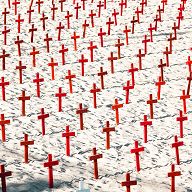People sentenced to death are held separately from the rest of the prison population. They are all incarcerated in Minsk prison, where the executions take place. This remand centre (Minsk Pretrial Detention Centre No. 1) is the only one placed under the authority of a special police force, the Committee for State Security (KGB). It is known for enforcing a more repressive policy than in other prisons.
Prisoners sentenced to death are subjected to maximum security restrictions. Their file is marked “inclined to escape“, “attacks on the administration” and “committing suicide”. They wear a special uniform with the inscription “exceptional measure of punishment”.
Human rights organisations agree that the living conditions of those sentenced to death in Belarussian prisons are inhumane and degrading. Two prisoners share one cell; these are equipped with a toilet and a sink; there is a bench and a table welded to the ground, and prisoners have a shelf to store letters. The ceiling is five metres high; a white light is always on; small opaque windows made up of three layers (gratings, grilles, and fixed shutters) line the walls; the dim light just about makes it possible to distinguish day from night, and the cell door has a hatch to pass meals through.
All cells are equipped with cameras. Guards perform checks through the peepholes every 15 minutes. CCTV images are continuously monitored by prison staff. Prisoners sentenced to death must keep their hands above the covers at all times during their sleep.
The law prohibits outdoor walks and activities for prisoners sentenced to death. They are not allowed to lay down or sit down between 6 AM and 10 PM. They usually spend the day walking around their cells. The prisoner must ask the guard if they can read a book or smoke a cigarette. The latter can be done through the hatch. The radio stays on all day.
Prisoners can only leave their cells to shower, receive visitors, and in the case of cell searches. When moving, they must keep their heads down and keep their hands cuffed behind their backs and placed above their heads. This position is considered humiliating. To move around prisoners sentenced to death, important security measures are deployed: up to ten guards escort the person, there is additional guarding by dogs, no other movement is allowed in the facility, all doors not in use by the “convoy” are kept locked, and staff must keep their distance from the chosen route.
Prisoners sentenced to death can receive a parcel or money every three months. They can buy food and basic necessities within the limits established by the administration.












